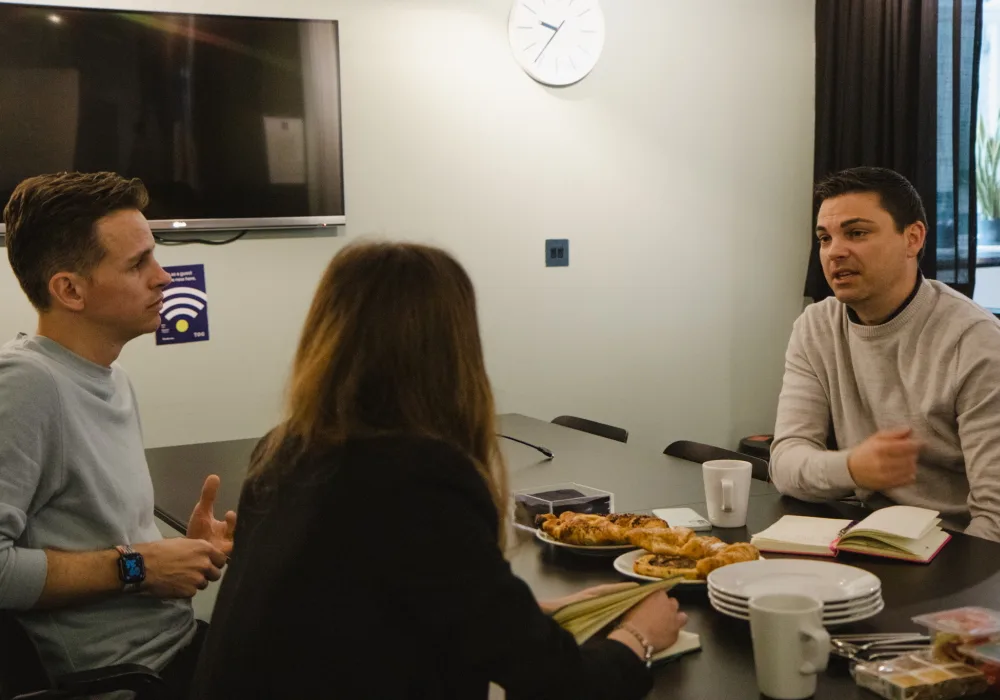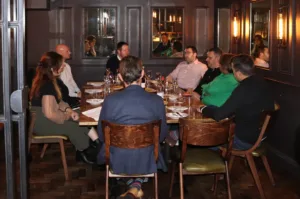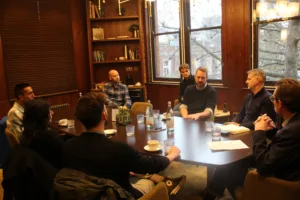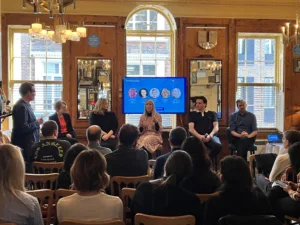Programmatic has been the main way for the industry to trade digital advertising for a number of years. Despite this, digital Out of Home (DOOH) is one area where automation hasn’t yet caught on across the board (excuse the pun). But this is all starting to change.
To discuss the changing landscape of DOOH, NDA teamed up with Sage+Archer to host a roundtable and gather the thoughts of some industry experts. We heard insights from Ryan Rummery, Commercial DAX Director at Global; Alys Donnelly, Head of Programmatic at Kinetic; Paul Barnard, Managing Director at Regital; Kate Williams, Media Strategy Director at Jellyfish; Ben Wilkins, Product Director at Skyrise Intelligence; James Trott, Head of Strategy & Product at Matterkind; and Diederick Ubels, Co-founder and CEO at Sage+Archer.
The free-flowing discussion, which could’ve gone on for several hours more, kicked off with a broader look at what programmatic means – both in general and in relation to the DOOH space.
Finding the perfect fit
Kinetic’s Donnelly acknowledged the real-time and data elements of programmatic, but made it clear that “the real point is that it adds value”.
“It adds agility in spaces where that wasn’t previously possible,” she said. “It adds value to a buy in a way that differentiates it from a classic two-week buy. So, amongst all those things, it’s a value adding force. It’s a real driver of the next stage of evolution in this space.”
At the same time, Donnelly warned against getting carried away with the use of programmatic. She added: “It’s not about promoting programmatic to the detriment of everything else that is working, and will continue to work in 10, 20, 30, 40 years. It’s about identifying the right use case, and tailoring that for a client in a way that makes absolute sense for them.”
This point was echoed by Skyrise’s Wilkins, who advised against the industry getting “too blinded” by the promises of programmatic and forgetting the long-standing best practices of traditional OOH.
“Programmatic is about being data-driven, efficient, in control, agile, and able to test and refine what works,” said Wilkins. “The goal is not to use data just because it’s there, it’s to use it to cut through with your message. And, if we don’t pair some of the learnings from the traditional landscape with the data capabilities that exist now, it’s not going to add value.”
Sage+Archer’s Ubels continued with the theme of “value” and agreed that it’s not about throwing programmatic at every situation, because it’s “more nuanced” than that: “There are players in our market that say it fits everywhere,” he commented. “It’s just an infrastructure; it’s just a way to buy. Whatever the campaign goals, or the budget, you can use it. But it’s a bit more than that to us.
“It needs to add value. It needs to be incremental. If you don’t use any data, or if it’s mostly based on a trade deal, then I don’t think programmatic has a role in that landscape. When the experience is truly automated and you can ingest data, it can add value at any level of the campaign.”
Automated everything?
On the other hand, Matterkind’s Trott believes that “programmatic fits anywhere that’s digital, and anywhere that can be biddable”. And he’s seeing positive signs that things are heading in that direction.
Trott said: “It’s great to see that most of our publishers and partners are buying into that and it’s going that way, because it will open up and allow choice. That’s what’s going to drive discovery and innovation, and really understand what the limits and capabilities are with this way of buying. It’s going to put us in a much better position to understand whether or not we should buy in one way or another.
“In terms of where it fits into the landscape, it’s anywhere that’s digital. Anywhere that’s biddable should be programmatically enabled. To what degree it’s bought that way will fall on us to decide. And we’ll get a lot better at that, but I think it should be everywhere, and it’s great to see that is the direction we’re heading.”
Regital’s Barnard agreed, pointing to what’s happened within the programmatic display ecosystem as an indication of what’s to come. He said: “In my opinion, it will probably all go programmatic. That’s not to say that the requirements will change, or that posters won’t exist. What we’ve seen in display, for example, is the technology platform becoming so important to manage scale.
“But it’s going to take time. It will be interesting to see if that’s a quick thing or, because there are fewer media owners than display and video, for example, it’s a longer thing.”
Easy access
Whether programmatic becomes the standard across all of DOOH remains to be seen, but we can be sure that automation will make the space far more accessible than it has been previously.
Global’s Rummery said: “Digital outdoor is well established, and programmatic is now truly emerging. It’s the most flexible access point, so whether you’re a small business looking to target a local audience with a data-driven campaign, or an established brand wanting to deliver objectives with a large scale, high impact campaign, it’s all possible.
“The more inventory that clients can access will naturally increase the number of campaigns they run. That in turn will enhance learnings, and over time, help to establish a clear role for programmatic on media plans. With all the added capabilities and data that is available via DSP’s (demand side platforms)combined with first party client data the benefits of programmatic are significant and the market will only continue to grow it’s a natural evolution
This accessibility was also highlighted by Jellyfish’s Williams, while focusing on how programmatic opens up opportunities for paid media teams. She added: “Buying programmatically is what they’re capable of doing day in and day out. And, by unlocking programmatic out-of-home, it just unlocks another platform, which is great from a media strategy perspective, because it’s another route to the consumer. And that’s ultimately what we’re looking for, for our brands. The accessibility is the key part of that.”
Although, alongside that excitement, Williams is aware that programmatic DOOH is not yet in a position to unlock big budgets, as clients will still lean toward approaches they know deliver “more immediate results”. As such, she believes “there is still a huge education piece that needs to be done to set a precedent of ‘this is what the channel’s role is. Let’s not commit it to doing something it can’t do’.”
The second part of the discussion can be read here.









